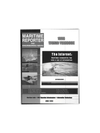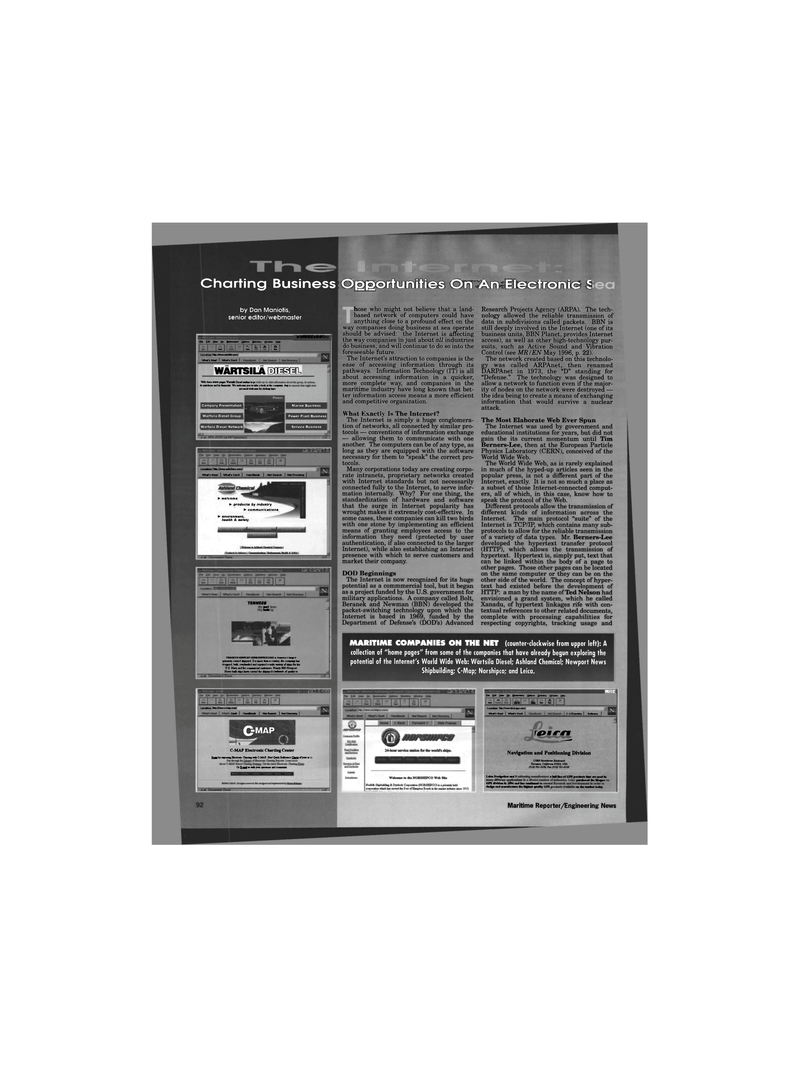
Page 106: of Maritime Reporter Magazine (June 1996)
Read this page in Pdf, Flash or Html5 edition of June 1996 Maritime Reporter Magazine
gle £cht )&r« Qo Bookmarks fiptons Qirectoiy Window b«lp imfffgWUBtFl 1 * a 1 & o H« 1 Opm SM»
Locution: htlp://w*w.wertsia.corn/
What's Nawi I What's Cooll I
WARTSILA mMML
With these www-page? Wartsila Diesel withe* to pi its ambitions and its finances. We welcome you to take a look at the company Any c< are most welcome by choking here
Company Presentation
Wartsila Diesel Group
Wartisila Diesel Network
Marine Business
Power Plant Business
Service Business
MARITIME COMPANIES ON THE NET (counter-clockwise from upper left): A collection of "home pages" from some of the companies that have already begun exploring the potential of the Internet's World Wide Web: Wartsila Diesel; Ashland Chemical; Newport News
Shipbuilding; (-Map; Norshipco; and Leica.
QMAP
M3E3!
Eta Ed* YS«w Qo Bookmarks Options Qirectewy window Help «s> • 1X1 i T?, i toe-u Ow Mm find
Location: h«p:/Aww.tei(»9P».com/
Whafs Newt [ WW* Cool) | it Directory [ Software I mq
Navigation and Positioning Division 23868 Ha»t*orf BaukvaM Tvrramt, California 9050S. USA (11(S> 791-5S00, Pax 0103 791-6108
Ldca Navigation and F my different appHn
GFS dlvblon la W* and kai emtnd to deaign and manufacture Ac Mgkast quality GTS prod« a hill Hne of GPS products (hat art used in purdiaied the Magna' on tke market today.
Maritime Reporter/Engineering News
Charting Business Opportunities On An Electronic J by Dan Maniotis, senior editor/webmaster
Location: MWAwwtMnap.com/
Cooa j Handbook | NtSatwt* j Wat Oiaaiawy | hose who might not believe that a land- based network of computers could have anything close to a profound effect on the way companies doing business at sea operate should be advised: the Internet is affecting the way companies in just about all industries do business, and will continue to do so into the foreseeable future.
The Internet's attraction to companies is the ease of accessing information through its pathways. Information Technology (IT) is all about accessing information in a quicker, more complete way, and companies in the maritime industry have long known that bet- ter information access means a more efficient and competitive organization.
What Exactly Is The Internet?
The Internet is simply a huge conglomera- tion of networks, all connected by similar pro- tocols — conventions of information exchange — allowing them to communicate with one another. The computers can be of any type, as long as they are equipped with the software necessary for them to "speak" the correct pro- tocols.
Many corporations today are creating corpo- rate intranets, proprietary networks created with Internet standards but not necessarily connected fully to the Internet, to serve infor- mation internally. Why? For one thing, the standardization of hardware and software that the surge in Internet popularity has wrought makes it extremely cost-effective. In some cases, these companies can kill two birds with one stone by implementing an efficient means of granting employees access to the information they need (protected by user authentication, if also connected to the larger
Internet), while also establishing an Internet presence with which to serve customers and market their company.
DOD Beginnings
The Internet is now recognized for its huge potential as a commmercial tool, but it began as a project funded by the U.S. government for military applications. A company called Bolt,
Beranek and Newman (BBN) developed the packet-switching technology upon which the
Internet is based in 1969, funded by the
Department of Defense's (DOD's) Advanced
Research Projects Agency (ARPA). The tech- nology allowed the reliable transmission of data in subdivisions called packets. BBN is still deeply involved in the Internet (one of its business units, BBN Planet, provides Internet access), as well as other high-technology pur- suits, such as Active Sound and Vibration
Control (see MR/EN May 1996, p. 22).
The network created based on this technolo- gy was called ARPAnet, then renamed
DARPAnet in 1973, the "D" standing for "Defense." The technology was designed to allow a network to function even if the major- ity of nodes on the network were destroyed — the idea being to create a means of exchanging information that would survive a nuclear attack.
The Most Elaborate Web Ever Spun
The Internet was used by government and educational institutions for years, but did not gain the its current momentum until Tim
Berners-Lee, then at the European Particle
Physics Laboratory (CERN), conceived of the
World Wide Web.
The World Wide Web, as is rarely explained in much of the hyped-up articles seen in the popular press, is not a different part of the
Internet, exactly. It is not so much a place as a subset of those Internet-connected comput- ers, all of which, in this case, know how to speak the protocol of the Web.
Different protocols allow the transmission of different kinds of information across the
Internet. The main protocol "suite" of the
Internet is TCP/IP, which contains many sub- protocols to allow for the reliable transmission of a variety of data types. Mr. Berners-Lee developed the hypertext transfer protocol (HTTP), which allows the transmission of hypertext. Hypertext is, simply put, text that can be linked within the body of a page to other pages. Those other pages can be located on the same computer or they can be on the other side of the world. The concept of hyper- text had existed before the development of
HTTP: a man by the name of Ted Nelson had envisioned a grand system, which he called
Xanadu, of hypertext linkages rife with con- textual references to other related documents, complete with processing capabilities for respecting copyrights, tracking usage and
C-MAP Electronic Charting Center
BjaBbye*p«***BeclrobcaiarlngaridiC-WAJ Find Quick Reference Qtet rfyonr at
Or Esrt a* Ml yaw question* aid ecaanein
Handbook [ Net Search | Net Directory |
Location: M^:/Awrtv.ashchem.com/
What's New! [ Whafs Cooll [
TEMNEe^ t* welcome • products by industry • communications
TENNECCS NEWPORT HEWS SHJPBUJLDWO is America's large«t privately-owned shipyard For more than a century, the company has designed, built, overhauled sod repaired a wide variety of ships for the
U.S. Navy and for commercial customers Nearly 800 Newport
News-built shq»s have carried the shipyard's hallmark ofquafcty to • environment, health & safety

 105
105

 107
107
